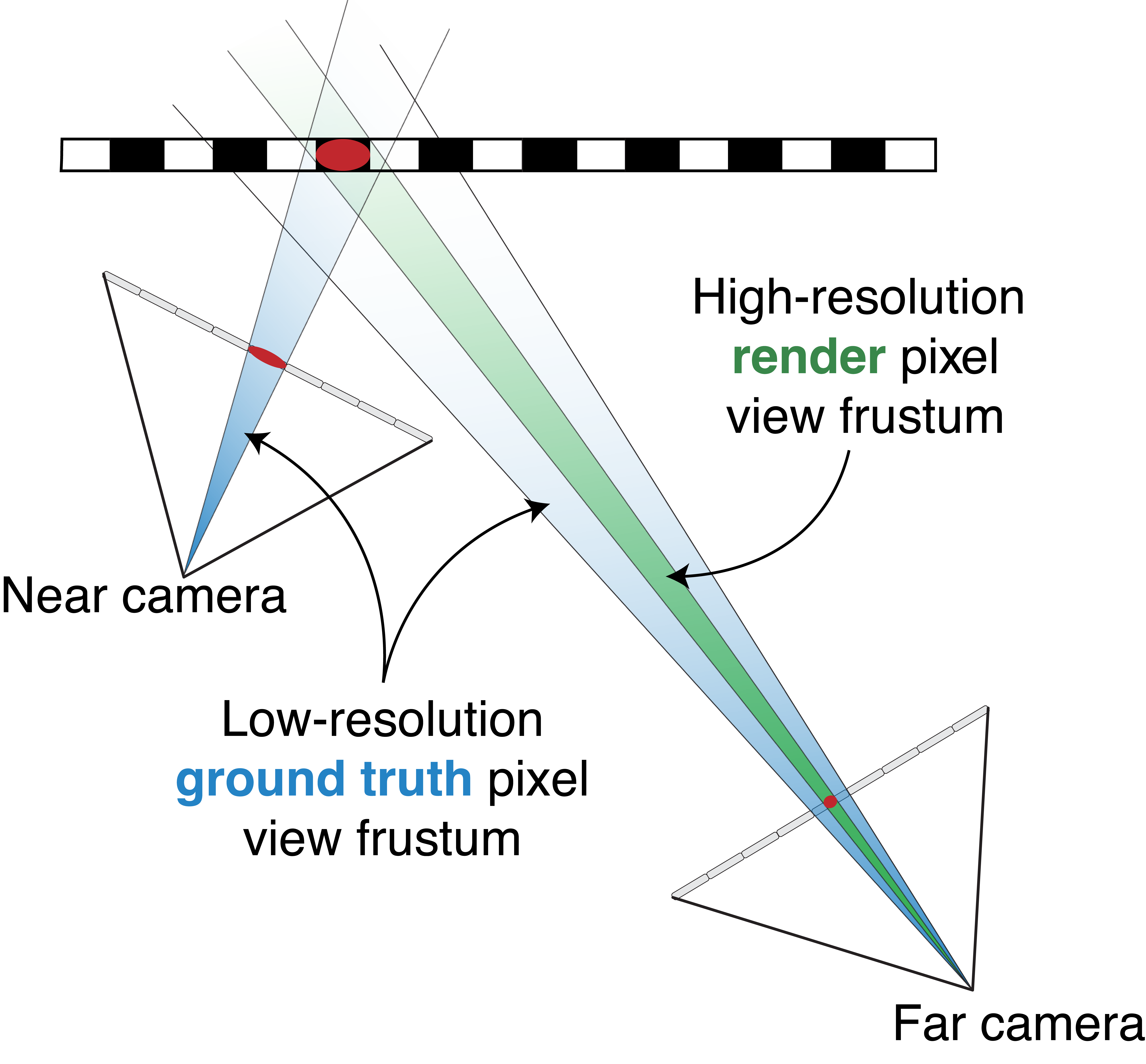
3D Gaussian Splatting (3DGS) enables high-quality novel view synthesis, motivating interest in generating higher-resolution renders than those available during training. A natural strategy is to apply super-resolution (SR) to low-resolution (LR) input views, but independently enhancing each image introduces multi-view inconsistencies, leading to blurry renders.
Prior methods attempt to mitigate these inconsistencies through learned neural components, temporally consistent video priors, or joint optimization on LR and SR views, but all uniformly apply SR across every image. In contrast, our key insight is that close-up LR views may contain high-frequency information for regions also captured in more distant views, and that we can use the camera pose relative to scene geometry to inform where to add SR content.
Building from this insight, we propose SplatSuRe, a method that selectively applies SR content only in undersampled regions lacking high-frequency supervision, yielding sharper and more consistent results. Across Tanks & Temples, Deep Blending and Mip-NeRF 360, our approach surpasses baselines in both fidelity and perceptual quality. Notably, our gains are most significant in localized foreground regions where higher detail is desired.
Prior approaches that integrate super-resolution (SR) into the 3DGS training pipeline apply it uniformly across every image, even in regions that are already well-supervised by nearby LR views. Since generated details are not necessarily multi-view consistent, injecting them everywhere can introduce geometric or texture inconsistencies, leading to blurred regions in the model.

SplatSuRe addresses this through a selective, geometry-aware strategy that determines where SR should influence optimization. Instead of treating all pixels equally, we exploit the multi-view sampling pattern of each Gaussian to determine which regions are sufficiently constrained by LR observations and which require additional SR guidance. To achieve this, we introduce:
Incorporating these weight maps into a combined LR–SR objective allows detail to be selectively injected where it is beneficial while preserving multi-view consistency elsewhere.
Images capturing a scene do not contribute equal amounts of high-frequency information for 3D reconstruction. A nearby low-resolution (LR) image can capture finer structure than a distant high-resolution (HR) view. SplatSuRe leverages this disparity to identify which 3D regions are already well-supervised and which require additional guidance from super-resolution (SR).

For each Gaussian \( \mathcal{G}^i \), we measure its screen-space footprint \( r^i_t \) in every training view \( t \). These radii describe how finely each Gaussian is observed across cameras. We then compute its sampling ratio:
\[ r^i_{min} = \min_{t\in T}{r^i_t}, \qquad r^i_{max} = \max_{t\in T}{r^i_t}, \qquad \rho^i = r^i_{max}/r^i_{min}. \]
A high ratio \( \rho^i \) indicates that the Gaussian is sampled at varying frequencies across views, meaning some views observe it with high fidelity and can supervise the others. A ratio close to one indicates uniform sampling across views, indicating that this region requires SR to add generated details. We convert this ratio into a normalized fidelity score:
\[ \mathrm{score}_{\mathcal{G}^i} = \sigma\!\left( \frac{\rho^i - \tau}{k} \right), \]
where \( \tau \) is a threshold and \( k \) controls transition smoothness. Gaussians in less than three views are assigned a score of zero. Higher scores correspond to Gaussians that are already well-captured by LR supervision, while lower scores identify regions where SR should be applied more heavily.
Supervising high-resolution model updates requires pixel-wise weight maps for each training view. For a given training view \( t \), we identify the set of Gaussians whose maximal radius occurs in its rendered view:
\[ \mathcal{M}(t) = \{\mathcal{G}^i\ |\ t = \arg\max_{t \in T}r^i_t \; \forall i \in N \}. \]
These are Gaussians that do not receive higher-frequency information from another view. We splat both the Gaussian fidelity scores and this closest-view mask to form a raw weight map:
\[ W'_t = \bigl(1 - \mathrm{Render}(\mathrm{score}_{\mathcal{G}})\bigr) + \mathrm{Render}(\mathbf{1}_{\mathcal{M}(t)}(\mathcal{G})). \]
The first term directs SR toward undersampled regions with low fidelity scores, while the second targets areas best observed by the current view because no other camera provides higher-resolution information. After normalization, the resulting weight map \( W_t \in [0,1] \) precisely identifies where SR should contribute during training, enabling SplatSuRe to enhance detail in poorly sampled regions while preserving multi-view consistency in well-supervised areas.
@article{Asthana2025SplatSuRe,
author = {Asthana, Pranav and Hanson, Alex and Tu, Allen and Goldstein, Tom and Zwicker, Matthias and Varshney, Amitabh},
title = {SplatSuRe: Selective Super-Resolution for Multi-view Consistent 3D Gaussian Splatting},
journal = {Preprint},
year = {2025},
url = {https://splatsure.github.io/}
}